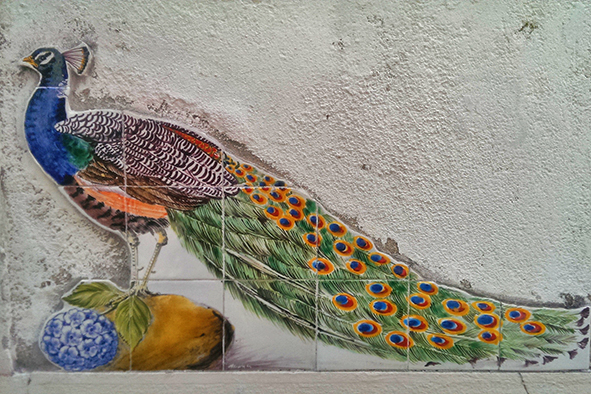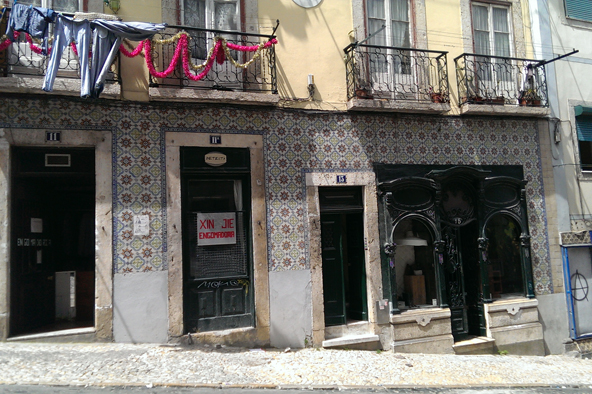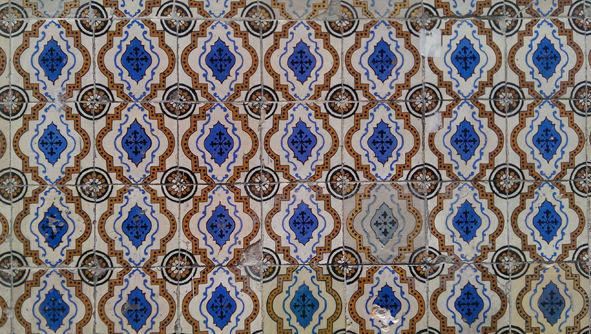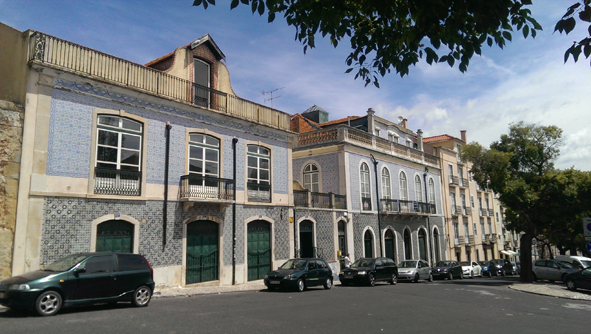Alfama is a tumble-down of Portuguese culture, harking back to the days when life was a merry concoction of arts and crafts, sardines, and traditional Portuguese wine. The winding streets act as a giant mosaic, pin-pricked with colourful tiles that paint a larger picture of the city. Houses are dressed up in geometric patterns, whilst intimate workshops prove the craft is still going strong.

Azulejo peacock (Photo: Lizzie Davey)
Garish paper chains looped their way across narrow streets, connecting up unattached balconies and adding a splash of colour to the otherwise dull stone architecture. Around every corner, where the streets expanded out into tiny cobbled squares, there was a flurry of activity as locals set up barbecue stands, trestle tables, and makeshift bars.
Cramped open-air restaurants popped up in every possible space, barely leaving any room to maneuver around. What had I expected, really? This was the build-up to the Feast of St Anthony, one of Lisbon’s biggest annual events that sees friends, family, and strangers gather together to gobble down sardines and clink glasses of red wine.
The preparations were well underway for the main event, where the city streets would dance into action in a carefully choreographed display of parades, performances, and feasts. And, whilst the entire city was filled with a jovial party spirit, it was in Alfama that the celebrations were most eagerly anticipated.
As the oldest part of Lisbon (and the only neighbourhood still intact after the destruction of the 1755 earthquake), Alfama has the strongest roots in Portuguese culture and heritage. Throughout the ages it has been a place of rich tradition, with a soulful, ancient narrative, from the time when fisherman ruled the streets to the present day.
It certainly helped that the hodgepodge laneways, with their uneven stonework and rusty old balconies, acted as a charming tunnel through time. Clothes billowed out from tiny terraces, whilst faded awnings hung over family-run restaurants that were a nightmare to find again.
But, though the Feast of St Anthony decorations masked the peeling layers of paint momentarily, and spruced up what could be, on colder, wetter days, eerie passageways, I was more intrigued by a much older decoration that sat silently beneath this garish display of colour.
The city’s azulejos are almost like a mascot; a decorative, historic mascot. Every wall in Alfama seemed to be plastered with chipped designs, whether they took pride of place on the side of buildings, or whether they took a little more work to find – huddled around gutters, or elaborately laid out on steps.
Every single design was different, bringing religious and historic scenes to life, immortalizing the city’s main attractions, or simply adding a dash of picturesque elegance to street signs, house numbers, and shop names.
The History of Alfama’s Azulejos
Though azulejo tiles are considered an extension of Portugal’s personality, they in fact originated in Egypt. However, over the years, Portugal (and especially Lisbon) has adopted the trend as its own, turning the craft of glazing tiles into a sophisticated art form that’s regaled the country for hundreds of years. Even today, azulejos are a prominent part of Lisbon’s culture – evidenced, of course, by the sheer quantity of them.
Let’s take things back to the 15th century. It was the Moors who introduced azulejos to Portugal, though at this point they were unrecognizable from their current flourishes of colour and intricate design. Back then, tiles were stark and geometric, reminiscent of ancient Arabic designs. This was in part because many of the Moors were in fact Sunni Muslims, where the creation of life through drawings and art was strictly banned, and partly because there just weren’t the tools to execute more intricate styles.
In the 16th century, the designs expanded to include floral and religious patterns brought to Portugal by Flemish artists. The colour palettes began to multiply, too, as the start of globalization meant there was access to new, exciting colours.
Then disaster struck in 1755, when an earthquake ravaged Lisbon, ripping and ruining almost all of the azulejo designs. But the patterned tiles were such an important part of Portuguese heritage, that the people of the city created new designs whilst rebuilding the city, bringing in even brighter colours and patterns to make up for their massive loss.
This history was almost tangible as I wandered the steep streets of Alfama. I could almost hear the pain in the crumbling buildings, and could almost feel the hopeful guise of the newer, shinier azulejo designs.
The Best Way to Explore Alfama’s Azulejos
Alfama is almost like a fairytale, with uneven houses leaning against each other for support, and quirky street formations that seem to lead nowhere and everywhere at the same time. This magical ambiance is helped by the Sant Jorge castle that sits at the peak, looking down over the mishmash of colourful roofs.
And, because the azulejos are everywhere, it’s best to take to the area by foot, getting lost in the maze of lanes and stopping at cute cafes to refuel along the way.
I stumbled across plenty of traditional blue and white designs surrounding St Stephen’s Church and the St Michael Church, both etching mural-sized religious scenes across passageways and high walls. But it was the simpler designs I liked best; the ones that appeared, unannounced, on charming guesthouses, above the balconies of rundown apartment blocks, and over the doors of boutique galleries.
There’s no set route for discovering the glazed gems of Alfama, because they are everywhere, and each one promises a new story, a new piece to add to your own Portuguese puzzle.
The tradition still continues today, with hidden workshops shearing out new designs on a daily basis. Wrinkled faces hunch over glazed sheets in shops that double as studios, where they effortlessly and humbly ensure this age-old quirk of Lisbon carries on for centuries to come.
So, whilst the vibrant paper chains of the Feast of St Anthony were enough to catch the eye and warrant a smile, it was the azulejos that really captured my heart. And, after the celebrations were over, the red wine drunk, and the sardines finished, the azulejos would still be there, presenting pockets of history around every bump and bend.


